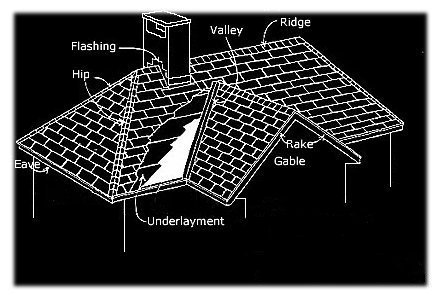 Home Home
 Roofing Services Roofing Services
 Estimates Estimates
 Testimonials Testimonials
 Six Questions Six Questions
 Anatomy of a Roof Anatomy of a Roof
 Career Opportunities Career Opportunities
 Mission Statement Mission Statement




Lake Orion Roofing Inc.
(248) 393-0055
(248) 393-2913 (fax)
Sales and Service:
sales@lakeorionroofing.com
General Information:
info@lakeorionroofing.com
Website & Advertising:
web@lakeorionroofing.com

|
|
The Anatomy of a Roof
 At Lake Orion Roofing, we like our customers to understand all different parts
and areas of their roof. This gives you, the customer, a better understanding
of how your home improvement project will be done. At Lake Orion Roofing, we like our customers to understand all different parts
and areas of their roof. This gives you, the customer, a better understanding
of how your home improvement project will be done.

Gable: The vertical triangular end of a building. Also, a type of roof.
Rake: The outer edge of the roof from the eave to the ridge.
Valley: The intersection of two sloping roofs joining at an angle to provide water runoff.
Flashing: The waterproofing construction used at intersections of different planes or at openings on a roof.
Hip: The intersection of two roof planes which meet to form a ridge that runs down the roof from the peak to the eave.
Eave: The lower border of a roof that overhangs the wall.
Metal Drip Edge: A narrow strip of noncorrodible metal used at the rake and eave to facilitate water runoff.
Exposure: The part of each shingle that is exposed to the weather.
Dormer: The structure containing a window set vertically and projecting through a sloping roof.
Ridge: An intersection of two roof planes forming a peak.
Mansard: A type of roof on which there are two slopes on each side, with the lower slope much steeper than the upper one.
Underlayment: A layer of asphalt saturated felt (sometimes referred to as tar paper) which is laid down on a bare deck before the shingles are installed.
Deck: The structural base for the roof. Made of wood or plywood.
Self-Sealing Shingle: A thermal-sealing cement built into the shingle to firmly cement the shingles together automatically after they have been applied properly and exposed to warm sun temperatures. In warm seasons, the seal will be complete in a matter of days. In colder seasons, sealing time depends on the temperature and amount of direct sunlight hitting the shingles.
Tab: The portion of the shingle set off by the cutouts. Also the part of the shingle that is exposed to the weather.
Architectural / Dimesional Shingle: The most popular type of fiberglass based asphalt shingle usually 12" x 36" in size.
|


 Home
Home Roofing Services
Roofing Services Estimates
Estimates Testimonials
Testimonials Six Questions
Six Questions Anatomy of a Roof
Anatomy of a Roof Career Opportunities
Career Opportunities Mission Statement
Mission Statement



 At Lake Orion Roofing, we like our customers to understand all different parts
and areas of their roof. This gives you, the customer, a better understanding
of how your home improvement project will be done.
At Lake Orion Roofing, we like our customers to understand all different parts
and areas of their roof. This gives you, the customer, a better understanding
of how your home improvement project will be done.